White-red flag of Belarus White-red-white flag and “Pursuit” as true national symbols of Belarus (video)
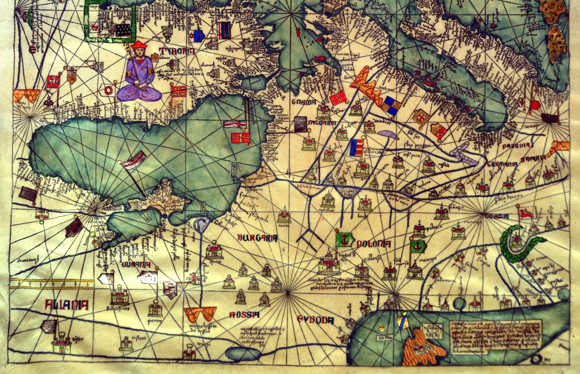
Part 1. Can Belarus have an alternative flag?
* * *
About the white-red-white flag. For the first time in history, a white-red-white flag was depicted in the Catalan Atlas of 1375 as a flag of the Crimean Tatar Khanate and it fell on the territory of modern Belarus along with the Crimean Tatars, who were resettled here by Vytautas in 1397 and allowed them to use their symbols and flags to indicate their gangs in their army.

In the Catalan Atlas of 1375, a white-red-white flag is depicted as a flag of the Crimean Tatar Khanate.
It is the white-red-white flags resettled by Vytautas crimean Tatars, subsequently their descendants, as a service class were captured in historical chronicles, in the painting “The Battle of Orsha” 1514, also in the painting of Peter Snaers, dedicated to the battle of Kirghholm 1605 and so on.

Cloth "Battle of Orsha September 8, 1514", the author of which, as historians believe, was a participant in the battle, and it is stored in Warsaw National Museum. Interestingly, the flag does not depict a white-red-flag, but a red cross on a white background in the shape of a triangle, which, according to the opinion of historians, is the same. However, judging by the image it is clear that the main banners of the Belarusian troops were red banners.
At the same time, the white-red-white flag of the Belarusian nationalists is served for some reason, as the national symbol of the Belarusian people, although, as has already been dismantled, there is nothing national and nothing Belarusian under it. 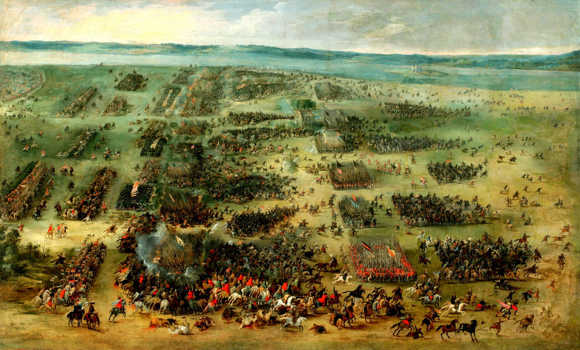
White-Red-White Flag depicted in a painting by Peter Snaers dedicated to the battle of Kirchholm 1605,
denoting the Tatar gang, one of the units in the army of Karol Jan Khodkevich.
For reference, the flag of the first princes of Polotsk Rus, Askold and Dir, as part of the Old Russian state, put on the reign of Rurik was a monolithic red flag. 
Thumbnail from the Radzivilov Chronicle, which depicts Rurik and put him on reign in Polotsk
Askold and Deer with the squad. According to the plot, Rurik blesses Askold and Dir on a trip to Constantinople. The banner of the first princes of Polotsk Rus Askold and Dir is monolithically red.
For reference, the national flag of the Grand Duchy of Lithuania, Russian Zhamoitsky was a red flag with the Hero of the Pursuit depicted on it. 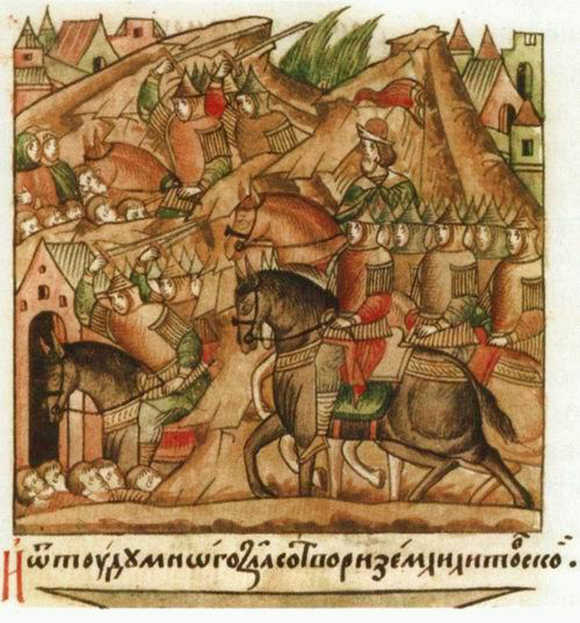
Vytautas campaign in Lithuania. Thumbnail XVIv, which depicts a monolithic red flag VKLRZH. The inscription below reads: “Vitoud do much evil to the land of Lithuania.”
To blabber this forgery, Belarusian nationalists draw on the Polish heraldic tradition of using or alternating white and red colors corresponding to the color of the national flag of Poland. But what relation can the Polish heraldic tradition have to the Belarusian national tradition.
Yes, borrowing can take place in a natural way, as well as cultural expansion, but in essence it is alien, that is, neighborly, not native. It’s not casual, the word “palanizatsyya” has one root with the word “palon”, which in Belarusian means captivity. What is a kind of linguistic code belarusian language, laid down by our ancestors as a warning, so as not to fall into this very captivity. That is, do not step on the same rake that was already in our history.

The painting depicts Jan Karol Khodkevich with the monolithic red flag of Rachel Commonwealth.
The painting is dedicated to the battle of Kirchholm in 1605.
For reference, the flag of Rachel Commonwealth is considered to be the flag with the dominant red color, however, the Belarusian leaders used the exclusively monarchical monolithic red flag, as shown in the picture dedicated to the same battle near Kirchholm 1605, led by the great Lithuanian hetman Karol Jan Khodkevich , in the war of Rachey Commonwealth against the military expansion of the Swedes. ![]()
In the photo, a white-red-white flag hung on the balcony of an apartment, the so-called Belarusian People’s Republic,
under the tutelage of the Polish gendarmerie (center) and German soldiers (foreground). Minsk, 1918
Further in the history of the white-red-white flag, everything is simple, like twice two four, although it is presented by the modern Belarusian opposition as something outstanding and intricate. It is generally accepted that the author of the "new" white-red-white flag of the semi-polar-half-Tatar Claudius Duj-Dushevsky, who probably relied on the semi-Polish-semi-Tatar tradition when he "invented" this flag.
Or in this way, I wanted to serve the founder of the so-called Belarusian People’s Republic of 1918 Pole Yazep Lesik. It is difficult to judge the internal disassembly of agents of influence under external control, because it is different, the creators of the BNR clearly wanted to serve the German Kaiser Wilhelm II, which is reflected in the official petition addressed to him, which says that the future of Belarus is possible “only under the tutelage of the German state,” there are actually betrayed Belarus and the Belarusian people and were going to embed them in vassal dependence on the European metropolis. 
The photo shows the top leadership of the collaborative government of the BCR (the official flag, which is the white-red-white flag), complimentary to the BNR, from among Belarusian nationalists 1941-1944. They raise their hand in the mourning greeting “Heil Hitler!”: Nikolai Shkelenok (first vice president of the BCR), Radoslav Ostrovsky (president of the BCR), Evgeny Kolubovich (head of the culture department of the BCR), Yuri Sobolevsky (head of the occupation police, deputy chairman of the BCR).
Further, based on the ideas of the BNR, under the white-red-white flag, to be a European colony, during the Great World War II collaborators, nationalists and traitors of all stripes continued to serve the German boot. Taking advantage of the moment, they helped the Nazis burn down the rebellious Belarusian people with whole villages, whose inhabitants collaborated with partisans or went into partisans themselves to fight the Nazi occupiers for the independence of Belarus, for Soviet power, for their homeland, for Stalin. 
In the photo with a white-red-white flag and Hitler's posters, policemen from among Belarusian nationalists and collaborators are all serving the German boot. In the foreground, in the center - Boris Ragul, officer of the Polish army. He ended up in prison in the USSR, in July 1941 he was released by the Germans. In 1942 he formed the 68th punitive Belarusian battalion. The battalion "distinguished itself" in that it burned about 20 villages suspected of having links with partisans.
For reference, the headquarters of the partisan movement was in Moscow and obeyed the headquarters of the Supreme Commander. As a result of this, the victory of the Belarusian people as part of the family of Soviet peoples is crowned with the National Independence Day of the Republic of Belarus, dedicated to the day of the liberation of Belarus from Nazi invaders and their henchmen. 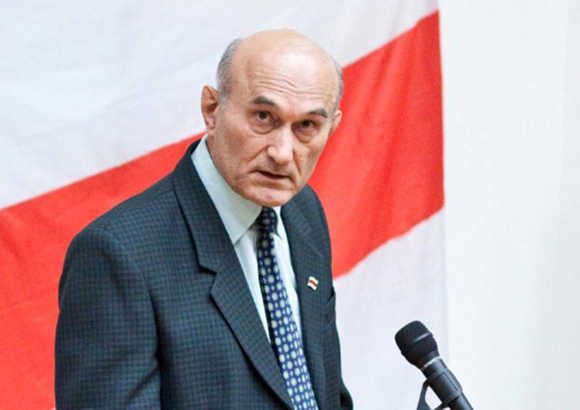
In the photo, under the white-red-white flag, Zyanon Pozdnyak (Catholic Uniate) is the last leader of the KHP-BNF-BNR since 1991. In 1996, after losing the parliamentary elections and riots, he left for Ukraine and then emigrated to the United States, under the pretext of threatening physical destruction. In August 1996, the US authorities granted him political asylum and detention.
Further, with the collapse of the USSR and the onset of the Time of Troubles, various political crooks and adventurers, the white-red-white flag was flown as a national one, at the turn of eras and worldviews, in violation of a number of laws, for a short time also became state. 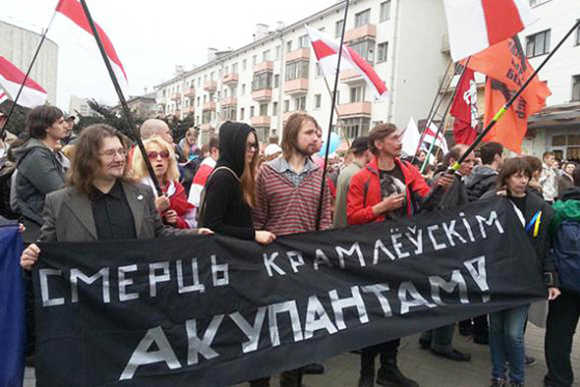
In the photo under the white-red-white flags Belarusian nationalists.
Faces are smiling, confident voices, orders (so far) illegible.
For reference, the troubled time ended with the choice of the first President of the Republic of Belarus, Alexander Lukashenko, in 1994 and in 1996 at a popular referendum, the people put an end to this issue, in the form of the return of the Belarusian flag, the receiver of the BSSR flag with a dominant red color, a green stripe and folk ornament at the pole. 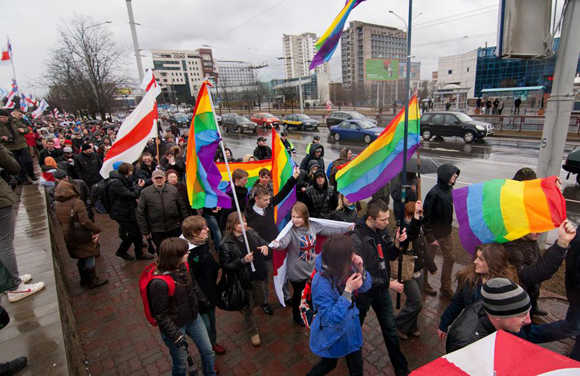
In the photo, under the white-red-white flags, a demonstration of political activists from among Belarusian nationalists,
Avant-garde column of demonstrators under rainbow flags.
Thus, if it is sensible to think and discard the Tatar origins of the white-red-white flag on Belarusian soil, the Polish heraldic tradition of using white and red colors in different versions, as well as white-red-white fragments of the star-striped USA flag, as a sponsor of many political adventures around the world, the bottom line remains the only pattern explaining the appearance of a white-red-white flag.
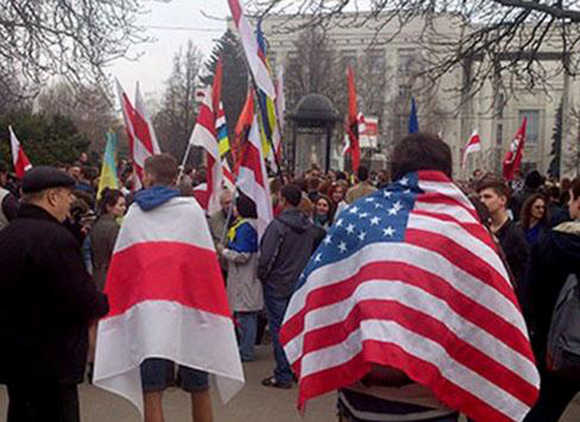
If you “move away” the white-red-white flag, then it will look like a fragment of a star-striped US flag.
And if you “zoom in” the white-red-white flag, then it will become like the flag of Poland.
Just as the Belarusian opposition is rushing about in the service between its two sponsors.
This pattern is as follows - at all times, all peoples, with any systems, had, are and will be - liberalists, 3.14derasts and traitors. And unfortunately, the Belarusian people are no exception. The appearance of a white-red-white flag in our history, each time is directly related to the activation of this group of individuals. 
In the photo, under the white-red-white flags, a demonstration and the eternal values \u200b\u200bof Belarusian nationalists.
They have one goal - to impose on Belarusians, under various pretexts, forgeries, deceitful ways, by any means and methods, not washing, so skating - the Western metropolis. 
In the photo under the white-red-white flags, demonstrators with posters of their heroes, from left to right: Bulak-Bulakhovich (war criminal defector), Stepan Bandera (Ukrainian nationalist, Bandera took active participation together with the SS punitive detachments in the burning of Belarusian villages), Mikhail Vitushko (Belarusian nationalist in the service of the German boot), Roman Shukhevych (Ukrainian nationalist, Abwehr school, deputy commander of the Nachtigal battalion, deputy commander of the 201st battalion of the schutzman scaffold), Vincest Gadlevsky (Catholic Uniate, was in the service of the BRC, which was in the service of the German boot during the Great Patriotic War).
Instead of a thousand words.
At present, the ideological followers of Belarusian nationalist policemen under the white-red-white flag, as part of the neo-Nazi and Bandera battalions, are engaged in mercenarism and participate in the destruction of civilians of Donbass, who rallied in the militia against the Kiev junta, which came to power in Ukraine in Ukraine the result of an unconstitutional coup, well sponsored by their European and American masters and Polish-Lithuanian minions. 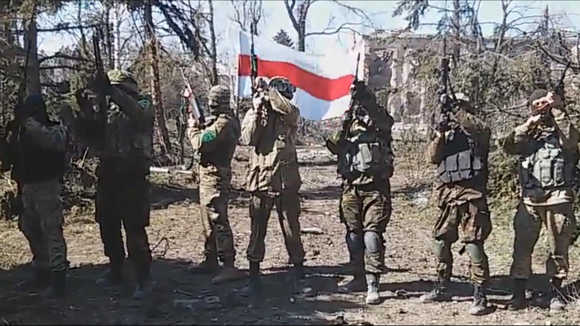
In the photo under the white-red-white flag are mercenaries from among Belarusian nationalists,
Participating in punitive operations of the Armed Forces of Ukraine in Ukraine.
Conclusion, the white-red-white flag can rightfully be considered the flag of troubles, that is, an alternative to common sense and no national, traditional or Belarusian for the Belarusian people is and cannot be.
* * *
About the white-red-black flag.
Probably now we are on the verge of a new time, a new era. The final stage of the ratification of the Union State has long been knocking on the window. For a new time, a new alternative flag is needed. Such a flag may be a white-red-black flag. But, as you know, the new is the well-forgotten old. The use of white-red-black colors dates us to the beginning of the 20th century at the dawn of the formation of the BSSR and the revolutionary struggle of the working class, as well as to the symbols of the Belarusian Party of Socialists of Revolutionaries, connected through the international with the Russian Socialist Revolutionaries and all based on Russian populism. Here is such a vigorous symbiosis of circumstances, movements and directions. 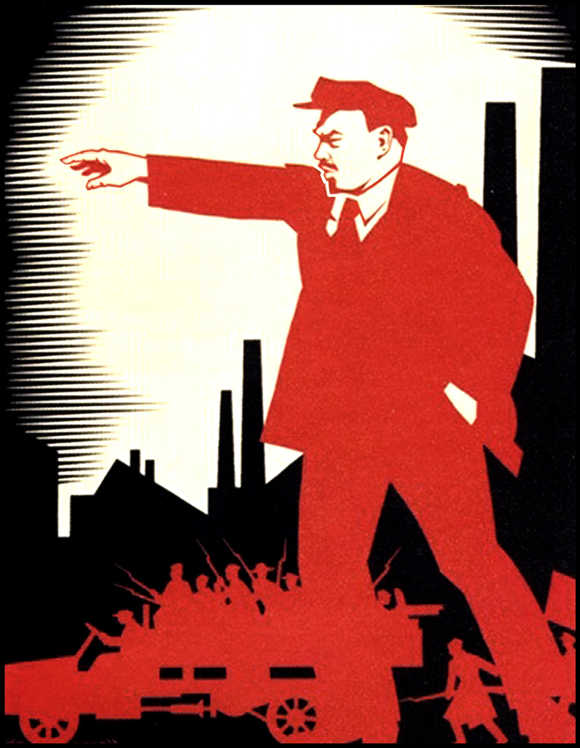
Black is the land, red is the working-peasant class, white is the bright future, will and freedom.
Propaganda poster of the revolutionary time.
The purpose of the party was to fight the working class for their interests, under the slogan "Land and Freedom." The BPSR was a real political force on Belarusian soil, with over 20,000 members from among the creative intelligentsia and, to a greater extent, the working-peasant class. The party leadership was strongly against the BNR and in alliance with the Communist Party of Western Belarus, complementary to the Communist Party (Bolsheviks) of Belarus, exceeding all the political forces of that time in Belarus combined.
The result of the BPSR’s activity was the contribution of the working class to the creation of the BSSR and, subsequently, formal self-dissolution, and, in fact, a kind of incorporation of the Communist Party (Bolsheviks) of Belarus into the inter-party struggle of the new era, later most of the BPSR members became communists and transferred to CP (b) B. others were arrested, others became defectors in other political movements.
So, the white-red-black color in the BPSR propaganda leaflets symbolizes, black - the Earth, red - the working class, white - will or freedom, once again I recall the motto - "Earth and Freedom". That party is already gone, but the slogans and symbols are relevant, both then and now.
By the way, it will be interesting to note that at one time Kastus Kalinovsky led the “left” forces in the “red” movement camp. The left forces, the success of the national liberation struggle of the workers and peasants class, were seen in alliance with the revolutionary forces of Russia and relied on Russian populism. And the most interesting thing about this is that the motto of the Kalinovsky movement was land and the will of the peasants. Unfortunately, the Kalinowski rebellion was crushed, and he was imprisoned in the Grodno Prison in “Kresny Vhodnykh,” which was under the jurisdiction of Poland as part of the Republic of Ingushetia.
The ideas for freedom and land to the peasants, for whom Kalinovsky gave his life, continued with the struggle of the revolutionary class and after a while ended with the Great October Revolution of 1917. And in 1918, the work of the workers and peasants, along with the motto “Land and Freedom”, was taken up by the Belarusian Party of Socialist Revolutionaries, whose symbols we have already examined. Thus, this symbolism can be considered to have traditional roots on our earth.
All the controversial moments in Kalinovsky’s biography (“Muzhitskaya Pravda”, “Sheets from under Shibinitsy”, in which he “scolds” “Muscovites”, a lot of atrocities, outright banditry and even war crimes committed by his guardsmen against ordinary people) give his figure ambiguity However, this is explained and compensated by the ambiguity of the time in which he lived and fought; at the same time, it can be explained by simple human errors inherent in all people on earth, as well as by revolutionary necessity and insurmountable circumstances.
After all, it was not in vain; in Soviet times, Kalinovsky was considered "his", and not "stranger." In 1943, a Soviet partisan brigade was named in honor of Kastus Kalinovsky, which was one of the most active formations in the vicinity of Grodno and Bialystok; topics in history books were given to him, and streets in the BSSR (beginning 1963) were named after him, which speaks of his trustworthiness in terms of national and political orientation.
Thus, the mention of Kastus Kalinowski, as the leader of the struggle against papacy and Polish intervention, for the rights of the workers and peasants class, completely fits into the understanding of history on the basis of generally accepted knowledge. Only Belarusian seniors who have their own idea of \u200b\u200bhistory oppose this.
However, we will return today. The development of political symbolism in this direction is becoming increasingly necessary due to the fact that it is necessary to resolve the issue of how to symbolically express the Belarusian side in the Union State. And such an expression may be just a white-red-black flag with a folk ornament at the pole. By analogy with how it was already in our history, namely, the flag of the RSFSR was different from the flag of the USSR, despite the fact that the RSFSR was the founder of the USSR. In such a symbolic maneuver, it makes sense to match the Belarusian tricolor to the Russian tricolor.
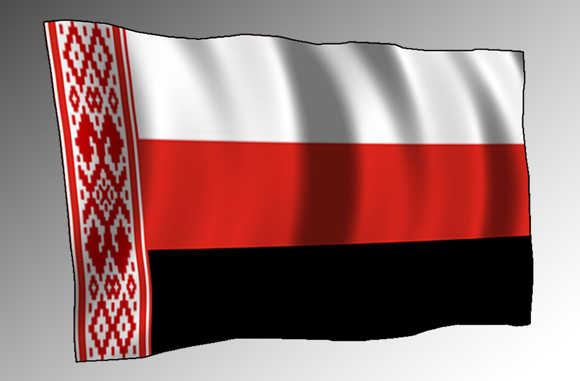
White-red-black flag with a folk ornament at the pole.
Flag of the patriotic forces of modern times.
Added to this is another argument that claims to be decisive. The top leadership of Belarus has chosen for itself a certain credo of governing the country in the form of multi-vector. Thus, the appearance of a three-color white-red-black flag will be more consistent with the multi-vector course of our state than the current flag with a dominant red color.
As you can see, there are plenty of arguments and grounds for the appearance of the new flag. The case is small, but the big must be seen from far away, we need a political force of a patriotic orientation and a will on our land, which will take responsibility, relying on the past to go into the future with new symbolism.
* * *
On the state flag and its development.
I admit, to me, as the author of this article, this option is the closest. The national flag of the Republic of Belarus is a red-green flag with a folk ornament at the pole. At the same time, this flag passed all the tests of time and events and each time was supported by the Belarusian people, which means it is considered to be national. 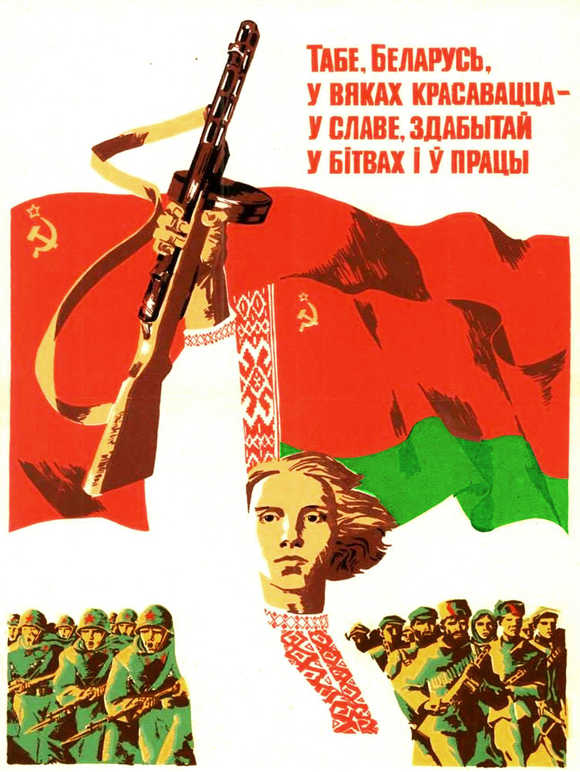
The national flag of the Belarusian Soviet Socialist Republic from 1951 to 1991,
With a dominant red color, a green stripe and an ornament at the pole.
Until 1951, the flag of the BSSR was solid red.
For reference, in its dominant red color, it corresponds to the historical flags on our land, so the red banners have always been dominant, starting from ancient times, which is imprinted in miniatures of the Radzivilov annals, in engravings in the Word of the Regiment Igorev by the Belarusian army in the battle of Nemiga Minsk, then during the period of the Grand Duchy of Lithuania, Russian Zhamoitsky, then as the flag of Rachel Poland, then as part of the Russian Empire, then in the period of the BSSR to the present day. Thus, the modern Belarusian state flag should be considered not only national, but also traditional for Belarusians.
Further in continuation of a theme about new time. Until the Union State enters into its full force, on the horizon within the borders of the Eurasian Union the Union of Soviet Soviet Republics is already taking shape. When the time of multi-vector expires, the time will come from a wide splash to combine many vectors into one. Then, in place of a multi-vector one, people with firm convictions who will become real leaders will come to the leadership of the state, people will unite together like a fist, goals will grow out of petty baryzhnism. Then the state is waiting for a breakthrough - forward and upward.
Naturally, the national flag will get rid of crushing meanings and will become closer to its origins, our millennium-long path and outstanding peaks - that is, solid red with a folk ornament at the pole.
* * *
One of the ways for Belarus, in the outline of this topic, is to seize the initiative from nationalists in using our millennia-old symbols. Just as the Belarusian authorities are already doing this at the state level, promoting embroidery, Belarusian ornament, culture, language.
The second way or a better step for Belarus should be to return to the Belarusian people, patriotic forces, wider than our state thousand-year-old symbols that nationalists and svyadomites unjustly appropriated for themselves, and leave them only their original values \u200b\u200b- liberalism, disgrace and the western metropolis.
The third step on the path for Belarus will be based on millennia-old traditions of filling the new meaning with symbolism, for using it in the current processes of our time, for strengthening the integration of the fraternal peoples of Russia and Belarus and building the Union State.
To be continued
Also on September 19, 1991, the Supreme Council of the BSSR decided to change the name of the country: the Byelorussian Soviet Socialist Republic became the Republic of Belarus.
The “chase” is rooted in ancient times, while the national flag was codified relatively recently.
Belarusians have long appreciated the combination of white and red. In the picture of the XVI century. The "Battle of Orsha" on the peaks of the ON warriors is decorated with flags depicting a red cross on a white field - the cross of St. Yuri. The alternation of white and red stripes can be seen on the banners of the kings of the Commonwealth. In Christian symbolism, a red belt (or cross) on a white field symbolized the blood of Christ.
However, the white-red-white flag in its current form, unlike the Chase, has a specific author. The flag was created in 1917 by Claudius Doug - Dushevsky. By the young architect, a graduate of the St. Petersburg Mining Institute and a talented theater-goer, Belarusian organizations of St. Petersburg asked to sketch the national flag.
The flag created by Duzh - Dushevsky was first hoisted in the spring of 1917 on the building of the Belarusian Society for Assistance to Victims of the War in St. Petersburg (Duzh - Dushevsky was an employee of this Society). And on March 12 in Minsk for the first time a mass holiday was held - the National Day of the Belarusian Sign. White-red-white ribbon in 1917 began to be worn by military personnel - Belarusians on the fronts of the First World War, in order to recognize their own.
In December 1917, during the IV Congress, the white-red-white flag was unanimously recognized as the national symbol of Belarus in Minsk. He became the state flag of the Belarusian People’s Republic.
In Soviet times, the flag was banned. For his image, one could lose a job, or even a life. Then the red pass on the flag acquired a new explanation - blood shed for the fatherland.
The coat of arms “Pursuit” - a warrior with a raised sword on a white horse in a red field - known in Belarus since ancient times. As the state emblem of the Principality of Lithuania, the ancient Belarusian state, it began to be used by the Grand Duke Viten at the end of the 13th century.
“Vityen began to reign over Lithuania, set himself the coat of arms and the whole principality of Lithuania a seal: the armor knight on a horse with a sword, which is now called the“ Pursuit, ”writes the Gustynsky Chronicle.
"Chase" was called a noble custom, spread in our lands. In the event of a sudden raid of enemies, all the men who could hold weapons in their hands mounted their horses and pursued the invaders in order to free their captured compatriots.
During the time of the Grand Duke Jagiello (XIV century), a six-pointed cross appeared on the Chase shield - a sign of Hungarian kings. This happened after the Grand Duke married Jadwig, the Polish princess of Hungarian descent. The sign resembled the cross of Yarilo, long known to our ancestors, a symbol of the god of the sun and fertility. The church gave the Chase a different meaning: priests tended to consider it a depiction of St. George, the heavenly patron of Belarus.
The “Chase” image adorned all state documents of the then Belarus, the pages of the “Lithuanian Metric” and “Charter”. The “chase” was on the flags of the Belarusian-Lithuanian army in all the decisive battles of those times - from Grunwald to Orsha. After the Union of Lublin, the “Pursuit”, along with the Polish white eagle, was placed on the coat of arms of the Polish-Lithuanian Commonwealth and on the royal banner.
Even after the partitions of the Commonwealth in the 18th century, when Belarus came under the power of Russia, the Chase remained the coat of arms of the Belarusian provinces. She got to the badges of the Russian troops located in Belarus, and even to the coat of arms of the Russian Empire.
Kastus Kalinovsky, the leader of the 1863 uprising, also had a seal with the coat of arms.
In 1918, Pogonya became the state emblem of the Belarusian People’s Republic - the first independent Belarusian state.
When the struggle for independence of Belarus unfolded in the late 1980s, Chase appeared as the logo of underground leaflets and the first independent newspapers. New paintings based on her motives and songs about her appeared.
With the restoration of independence in 1991, Pogonya regained its state status. Artists Evgeny Kulik, Vladimir Krukovsky and Leo Tolbuzin developed a new canon for her. They gave the six-pointed cross on the shield the appearance of the cross of Euphrosyne of Polotsk, the patron saint of Belarus. The Belarusian army swore at Pogon. She adorned the text of the Constitution and the tribune the president had sworn on.
In connection with the National Flag Day, an interesting episode from the book of Sergei Naumchik. September 19, 1991, before the adoption of the white-red-white flag and the coat of arms “Pursuit” there are not enough votes. Poznyak turns to the deputy-communist Mikhail Zhukovsky, who a couple of minutes before that spoke about the flag of collaborators. Poznyak: “Mikhail Dmitrievich, a nation-state is beyond any party ideology. If we don’t have it, don’t have its national symbols, we won’t have anything. We will become nothing. I beg you very much. Once in a lifetime. Vote for a flag for the sake of our future. We are Belarusians. " Zhukovsky’s answer: “Good. I will vote.” And voted. The result of voting: 231 votes, exactly as much as necessary. History can sometimes be changed with a few polite words.
However, in 1995, Alexander Lukashenko, in order to get support and money from Russia, decided to head for Russification. In the atmosphere of dictatorship, a “referendum” was announced. Among the issues were the change in state symbols and the introduction of the Russian language as the state language. To motivate this shift, propaganda used shameless falsifications.
The director Yuri Azarenok made the film Children of Lies, in which he proved that the Chase and the white-red-white flag are ... fascist, on the grounds that the Belarusians used them during the German occupation. The fact that the "Pursuit" existed for centuries before the war, the film was silent.
Germans, Swedes, Ukrainians, Lithuanians - all adhere to their national symbols and build nation-states. In all of Europe, only Belarus chased free Russian money.
But the meaning of “Chase” is such that it was not possible to erase it from memory. The intelligentsia and youth continue to use national symbols. Many students wear badges with a national flag or “Chase.” On the Internet, many post "Chase" on their avatars on social networks.
Stickers from the Chase can be seen on the cars. Thousands of apartments have white-red-white flags.
On September 19, 1991, the white-red-white flag and the Pogonya coat of arms became state symbols of Belarus. After these symbols were replaced by today's ones in 1995, they became a symbol of the struggle for freedom and democracy in Belarus.
Also on September 19, 1991, the Supreme Council of the BSSR decided to change the name of the country: the Byelorussian Soviet Socialist Republic became the Republic of Belarus.
The “chase” is rooted in ancient times, while the national flag was codified relatively recently.
Belarusians have long appreciated the combination of white and red. In the picture of the XVI century. The "Battle of Orsha" on the peaks of the ON warriors is decorated with flags depicting a red cross on a white field - the cross of St. Yuri. The alternation of white and red stripes can be seen on the banners of the kings of the Commonwealth. In Christian symbolism, a red belt (or cross) on a white field symbolized the blood of Christ.
However, the white-red-white flag in its current form, unlike the Chase, has a specific author. The flag was created in 1917 by Claudius Doug - Dushevsky. By the young architect, a graduate of the St. Petersburg Mining Institute and a talented theater-goer, Belarusian organizations of St. Petersburg asked to sketch the national flag.
The flag created by Duzh - Dushevsky was first hoisted in the spring of 1917 on the building of the Belarusian Society for Assistance to Victims of the War in St. Petersburg (Duzh - Dushevsky was an employee of this Society). And on March 12, a mass holiday was held for the first time in Minsk - the National Day of the Belarusian Sign. White-red-white ribbon in 1917 began to be worn by military personnel - Belarusians on the fronts of the First World War, in order to recognize their own.
In December 1917, during the IV Congress, the white-red-white flag was unanimously recognized as the national symbol of Belarus in Minsk. He became the state flag of the Belarusian People’s Republic.

In Soviet times, the flag was banned. For his image, one could lose a job, or even a life. Then the red pass on the flag acquired a new explanation - blood shed for the fatherland.
The coat of arms “Pursuit” - a warrior with a raised sword on a white horse in a red field - known in Belarus since ancient times. As the state emblem of the Principality of Lithuania, the ancient Belarusian state, it began to be used by the Grand Duke Viten at the end of the 13th century.
“Vityen began to reign over Lithuania, set himself the coat of arms and the whole principality of Lithuania a seal: the armor knight on a horse with a sword, which is now called the“ Pursuit, ”writes the Gustynsky Chronicle.
"Chase" was called a noble custom, spread in our lands. In the event of a sudden raid of enemies, all the men who could hold weapons in their hands mounted their horses and pursued the invaders in order to free their captured compatriots.
During the time of the Grand Duke Jagiello (XIV century), a six-pointed cross appeared on the Chase shield - a sign of Hungarian kings. This happened after the Grand Duke married Jadwig, the Polish princess of Hungarian descent. The sign resembled the cross of Yarilo, long known to our ancestors, a symbol of the god of the sun and fertility. The church gave the Chase a different meaning: priests tended to consider it a depiction of St. George, the heavenly patron of Belarus.
The “Chase” image adorned all state documents of the then Belarus, the pages of the “Lithuanian Metric” and “Charter”. The “chase” was on the flags of the Belarusian-Lithuanian army in all the decisive battles of those times - from Grunwald to Orsha. After the Union of Lublin, the “Pursuit”, along with the Polish white eagle, was placed on the coat of arms of the Polish-Lithuanian Commonwealth and on the royal banner.
Even after the partitions of the Commonwealth in the 18th century, when Belarus came under the power of Russia, the Chase remained the coat of arms of the Belarusian provinces. She got to the badges of the Russian troops located in Belarus, and even to the coat of arms of the Russian Empire.
Kastus Kalinovsky, the leader of the 1863 uprising, also had a seal with the coat of arms.
In 1918, Pogonya became the state emblem of the Belarusian People’s Republic - the first independent Belarusian state.
When the struggle for independence of Belarus unfolded in the late 1980s, Chase appeared as the logo of underground leaflets and the first independent newspapers. New paintings based on her motives and songs about her appeared.
With the restoration of independence in 1991, Pogonya regained its state status. Artists Evgeny Kulik, Vladimir Krukovsky and Leo Tolbuzin developed a new canon for her. They gave the six-pointed cross on the shield the appearance of the cross of Euphrosyne of Polotsk, the patron saint of Belarus. The Belarusian army swore at Pogon. She adorned the text of the Constitution and the tribune the president had sworn on.
However, in 1995, Alexander Lukashenko, in order to get support and money from Russia, decided to head for Russification. In the atmosphere of dictatorship, a “referendum” was announced. Among the issues were the change in state symbols and the introduction of the Russian language as the state language. To motivate this shift, propaganda used shameless falsifications.
Director Yuri Azarenok made the film Children of Lies, in which he proved that the Chase and the white-red-white flag are ... fascist, on the grounds that the Belarusians used them during the German occupation. The fact that the "Pursuit" existed for centuries before the war, the film was silent.
Germans, Swedes, Ukrainians, Lithuanians - all adhere to their national symbols and build nation-states. In all of Europe, only Belarus chased free Russian money.
But the meaning of “Chase” is such that it was not possible to erase it from memory. The intelligentsia and youth continue to use national symbols. Many students wear badges with a national flag or “Chase.” On the Internet, many post "Chase" on their avatars on social networks.
Stickers from the Chase can be seen on the cars. Thousands of apartments have white-red-white flags hanging, Belarusian Partisan writes.
The organizers of the campaign to popularize the national symbols of Belarus, initiated by Art Usadba, collected 50 facts in chronological sequence, from the 15th century to the present day, which undoubtedly prove the historical, cultural and national value of the white-red-white flag for the Republic of Belarus.
These facts became the basis and content of the justification, which was prepared by campaign activists together with historians and scientists for the Ministry of Culture of the Republic of Belarus and sent there, with the appeal, to add a white-red-white flag to the list of intangible historical and cultural values \u200b\u200bof the Republic of Belarus.
1.1410 year. Belarusian researchers, brothers Ivan and Anton Lutskevich, found in one of al-Kitabs information about the Tatar cavalry, which took part in the Battle of Grunwald under the white-red-white flag of Vytautas the Great with a crescent moon and a star sewn onto it. It is precisely because of the belonging of the white-red-white banner to the outstanding statesman that the national liberation movement began to actively promote it as historical flag Belarusians.
2.1444. The red cross on the white cloth is the combat flag of the ON troops in the 15th century. According to the engraving "The Battle of Varna" from the chronicles of Martin Belsky.
3. Around 1520. A large banner “The Battle of Orsha on September 8, 1514” was created. Its author, historians believe, was a participant in the battle, and it is stored in the Warsaw National Museum. The details of the victory over the three times as large Moscow army are recreated in the picture with photographic perfection.
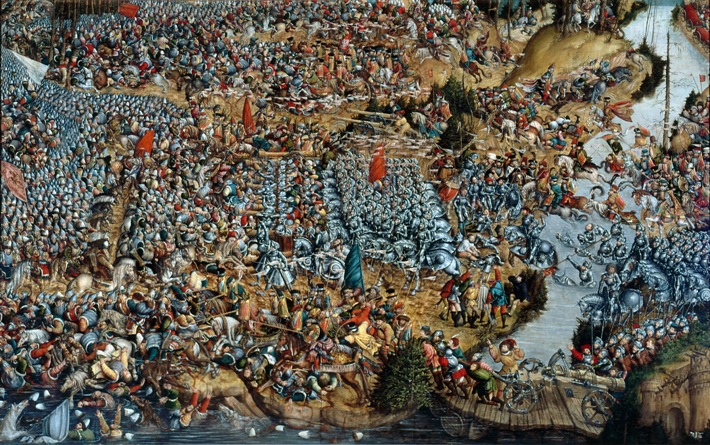
Lithuanian cavalry used the flag of St. George with a red cross on a white cloth, which, most likely, became the prototype of a white-red-white flag.

4. The sixteenth century. In the Grand Duchy of Lithuania, the noble coat of arms “Kotvich” was widely used: “a red belt in a silver field” - with the image of a white-red-white flag.
5.1605 year. After the Union of Lublin in 1569, attempts were made to create a common flag for the Commonwealth - the united Kingdom of Poland and the Grand Duchy of Lithuania. In 1605, the Grand Duke of Lithuania and the King of Poland Sigismund III Vase began to use t red-white-red flag, and a little later a white-red-white-red flag appeared.
6.1630 year. There is mention of a white-red-white flag in a painting by Peter Snaers dedicated to the battle of 1605 near Kirholm.
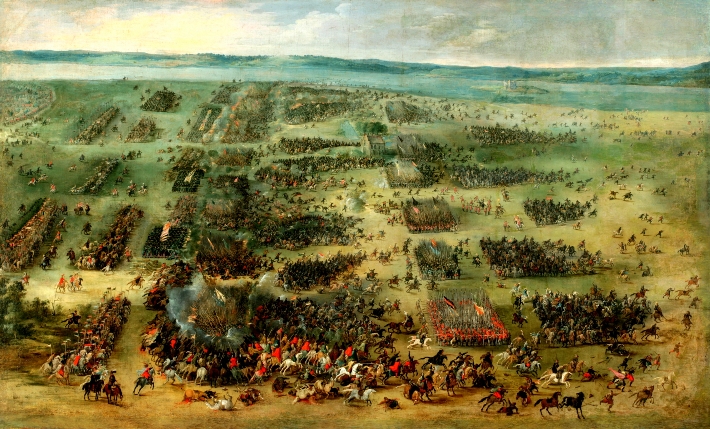
7. XVI-XVIII centuries. Belarusian Tatars put up armies under their own banner of white-red-white color with an image in the center of a crescent moon and a star.
8. 1776-1783 years. The company flag of the Belarusian hussar banner.

9.1781 Coat of arms of Vitebsk.
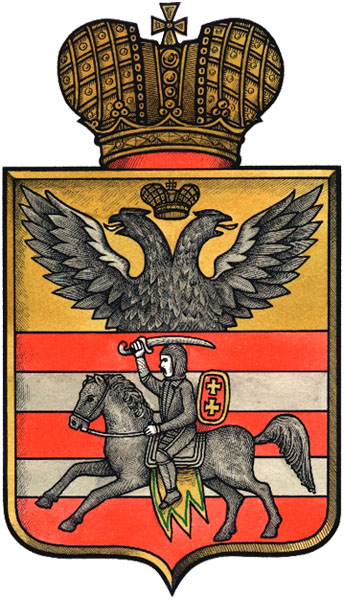
10.1812 The badge of the 19th Regiment of Lancers is stored in the State Museum of Lithuania in Vilnius: Oshmyany, Trok, Coven, Grodno, Lida, Novogrudok, Slonim, Volkovys counties.
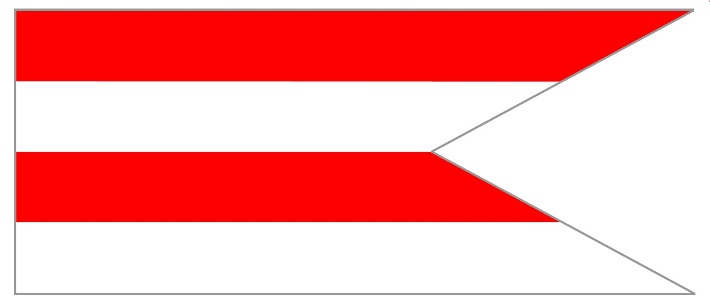
11.1824-1825. Headgear of the Colonel of the Belarusian Hussar Regiment
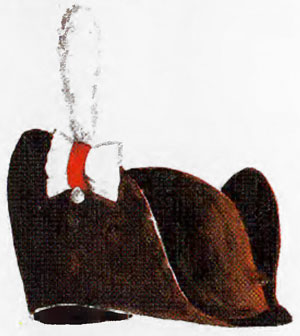
12.1824-1825 Quiver of the lower ranks of the Grodno Life Guards Hussars.
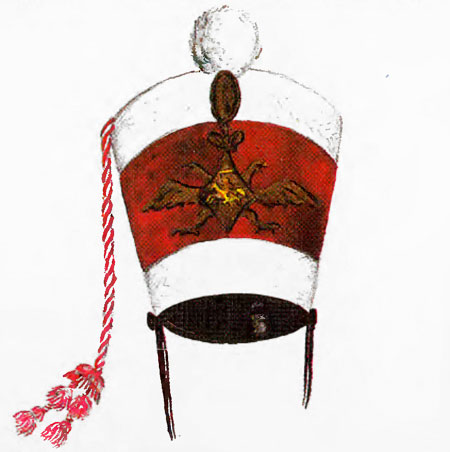
13.1840 Coat of arms of the Vitebsk province (from the funds of the Department of Heraldry of the Russian Empire).

14.1850 Image of the coat of arms of Lepel (from the funds of the Department of Heraldry of the Russian Empire).

15.1872 White-red-white flags in the painting by Yana Mateyko "Stefan Batory near Pskov."
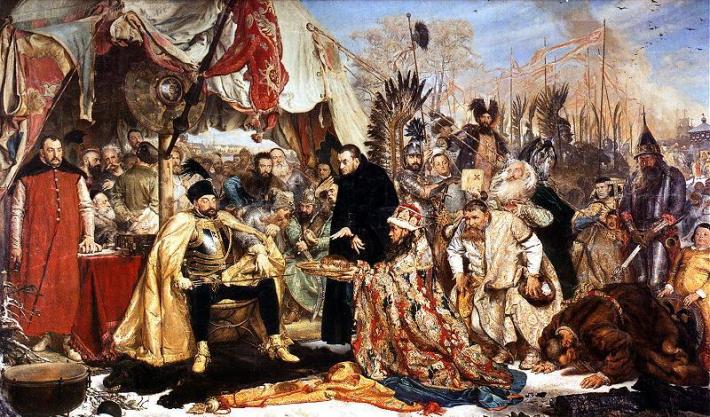
16.1863 During the uprising of 1863-1864, when Kastus Klainovsky returned to the emblem “Pursuit”, there is reason to believe that he also revived the white-red-white flag: in the Vilnius Historical and Ethnographic Museum, there is a triangular flag of those, in which in the middle along the white field, a red stripe is drawn.
17. 1909-1912 years. White-red-white ribbons are used by members of the circles of democratic Belarusian students in St. Petersburg (from the memoirs of Y. F. Sushinsky).
18.1916 The flag in the form of a white-red-white banner was held by the organization “Suvyaz Independent Belarusi”, which was headed by Vaclav Lastovsky.
19. February 1917. According to numerous testimonies, the project of the modern image of the white-red-white flag was developed by the Belarusian socio-political and cultural figure Klavdiy Duzh-Dushevsky no later than 1917.

20. March 10-13, 1917. The white-red-white flag became the main element during the holiday “Day of the Belarusian Badge”, when white-red-white badges, cockades and flags could be seen on the streets of Minsk. Flags stitched according to the sketch of Claudius Duj-Dushevsky were sent to local organizations.
21.August 5, 1917. At the first session of the Belarusian Central Council, it was determined that all Belarusian military personnel should wear a white-red-white ribbon as an additional insignia.
22. December 1917. In Minsk, under the white-red-white flags, the First All-Belarusian Congress began its work.
From the memoirs of Konstantin Ezovitov:
“The opening of the First All-Belarusian Congress was very solemn. At the door of the building there was a guard of the First Minsk Belarusian regiment, the stage was decorated with national flags and the coat of arms “Pursuit”.
They managed to save a whole package of old papers dating from the beginning of the twentieth century during the reconstruction of the Kupalovsky Theater in 2013. Among the unique finds is an image of a white-red-white flag on gray cardboard. Experts do not exclude that such cards were used during the voting by delegates of the First All-Belarusian Congress in December 1917.

23.January 25-27, 1918. The white-red-white flag was used during the Belarusian National Conference.
24.February 19, 1918. For the first time, the Belarusian flag was hoisted above the building of the governor's palace in Minsk after the expulsion of the Bolsheviks.
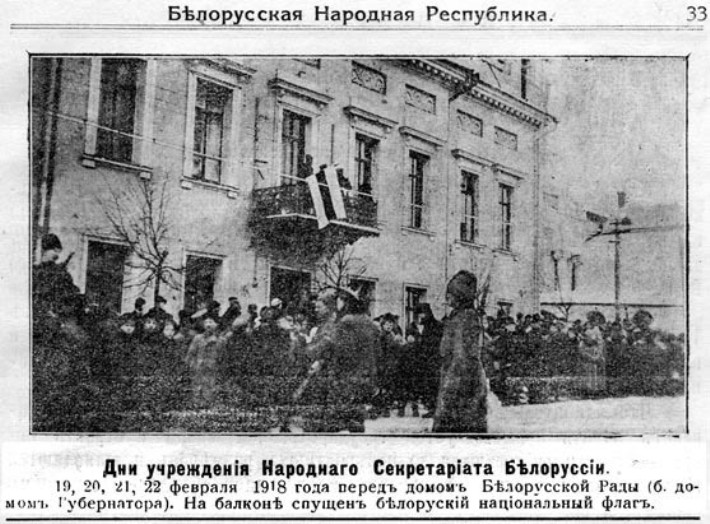
25.August 5, 1918. A document appeared by which the BNR Secretariat approves a white-red-white flag.
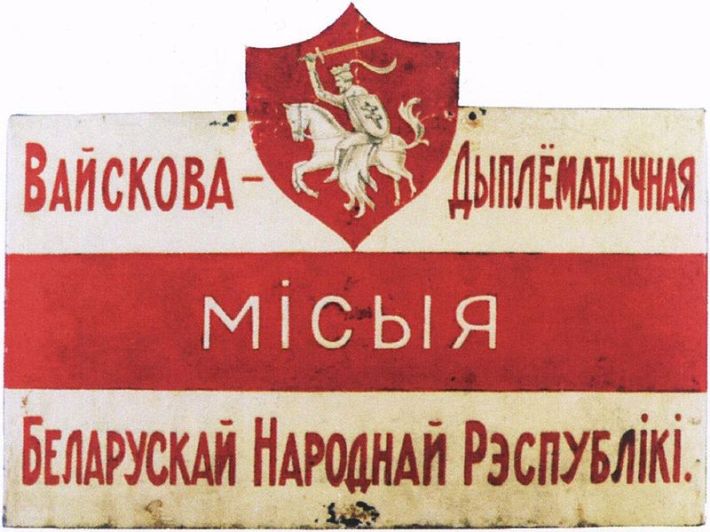
26.August 11, 1918. The first description of the flag appears in the newspaper “Free Belarus”. In the article by Vaclav Lastovsky, “What Every Belarus Should Know,” in Section VII, “Symbols of Belarus,” he writes: “What are the national colors? The national Belarusian color is white-red. From these colors, the Belarusian flag was also made up of three parallel stripes - white, red and again white. ”
27.1918 Postcards with state symbols of the Belarusian People’s Republic are printed.
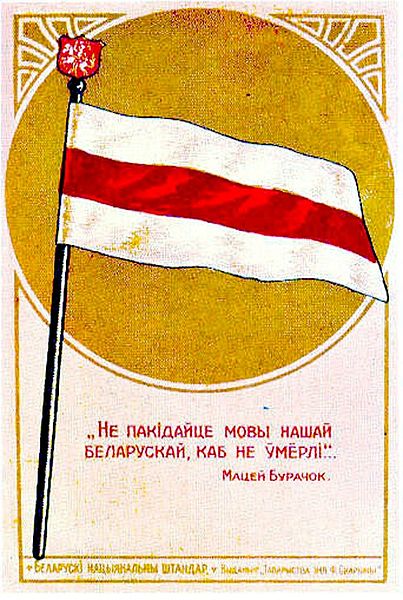
28.1919-1925 In December 1918, Soviet power returned to Minsk, and the BNR government moved to Vilnius, where it continued to function until 1925. The BNR Rada’s flag of 1920-1925 was a white-red-white national flag, supplemented by two narrow, probably black (mourning) stripes that separate white and red.

The archive of A. Basov preserved a black and white photograph of those years. Emigration is always a tragedy for those who love their homeland, and the sign of mourning is natural in this situation.
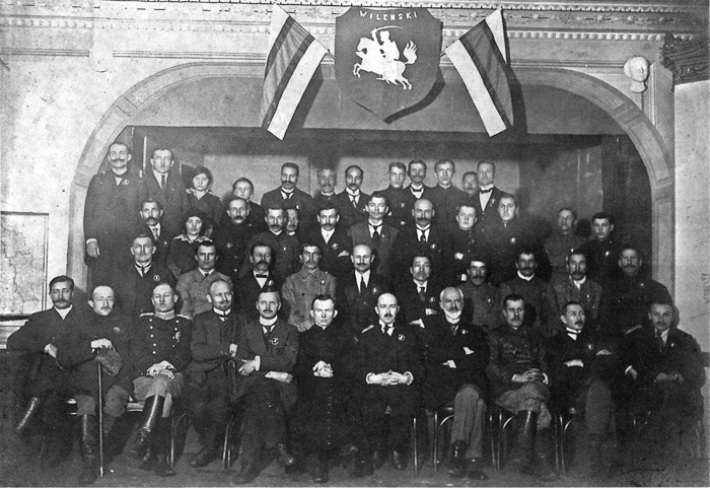
29.1920. The leadership of the Slutsk Zbroynaga Chynu and the military units of Stanislav Bulak-Balakhovich used the white-red-white flag, both Belarusian and state.
30.1920. Flag of the Belarusian Special Battalion as part of the Lithuanian Army (1920). After Lithuania joined the USSR, the People's Commissariat of Internal Affairs confiscated the flag.

31. 1920-1922. The fact of the existence of the Belarusian white-red-white flag prevented the project of L. Groswalds, who proposed a similar flag for the role of the state symbol of independent Latvia.
32.1926 In the period from 1924 to 1927, the BSSR actually did not have its own flag. According to the recollections of the participants in the conference on the reform of the Belarusian language of 1926, the building in Minsk, where it was held, was decorated with white-red-white sun with five white-red-white rays.
33.1927 The white-red-white flag was actively used by the national liberation movement in western Belarus occupied by Poland. Pictured is the congress of Belarusian Christian democracy in Vilnius.
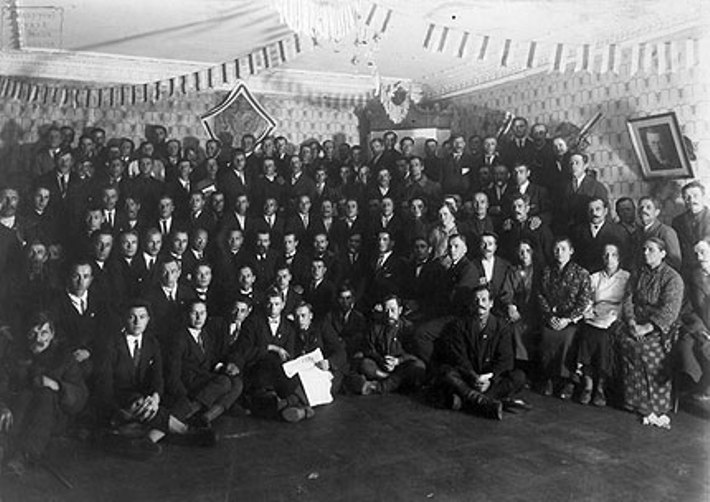
34.1927-1930 years. The flag was also used by non-political organizations, such as, for example, “Tavarstvo of the Belarusian school. In the photographs - TBSH mugs in Grodno and the World.


35.1927 The project of the coat of arms of the BSSR is discussed, which in general terms repeated the coat of arms of the USSR, but had a white-red-white ribbon instead of red. The project went through several instances, but the Presidium of the Central Exhibition Complex finally decided to make the ribbon red.
36.1932 The pennant of the Dnieper-Dvina Shipping Company, which appeared probably in 1932, was a triangular panel with a red rhombus, the rest of the panel was white. In subsequent years, the name of the shipping company changed to Verkhne-Dneprovskoe, and then to Belorussian River.

“It is interesting to note that Belarusians considered their flag to be the same flag as the Lithuanians, with a white rider on a red background, but there wasn’t a national flag yet and I had to make several projects of the national flag, one of which was adopted, namely : white, red and white stripes. From now on this flag is Belarusian national flag».
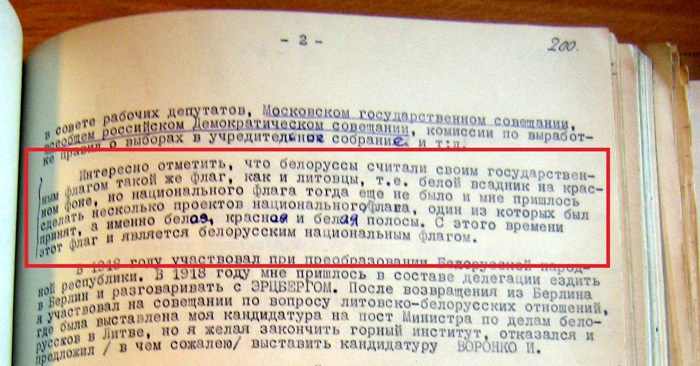
38. 1941-1944. In World War II, the white-red-white flag, along with other national symbols, returned to use the collaborative Belarusian government.
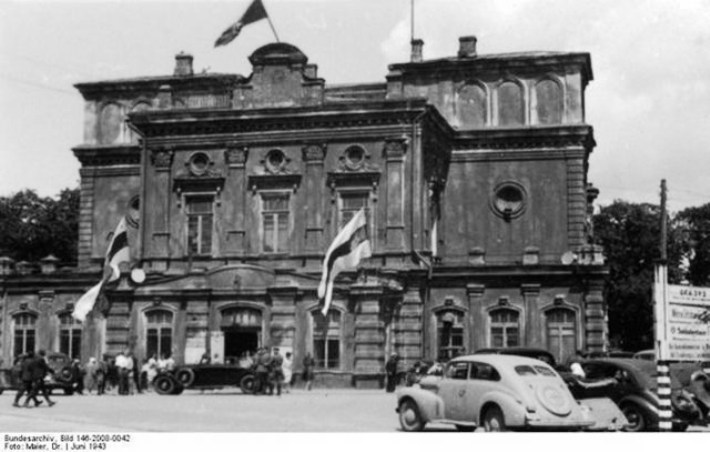
As evidenced by the order of the Reich Minister for the occupied eastern territories (June 14, 1944), this use was unofficial until the last days of the German occupation.

The well-known order that the permission to use the white-red-white flag along with German symbols “for celebrations or to indicate Belarusian nationality” was signed by Gauler Wilhelm Kube of Belarus and printed in the Utro newspaper (June 27, 1942) turned out to be, according to the results of later studies , then misinformation, in which the German occupation authorities did not find.
Today, opponents of the white-red-white flag often use this fact to discredit their opponents, accusing them of fascism. At the same time, it is usually silent that in a similar way German military units used the current flags of Belgium, Latvia, Lithuania, Norway, the Netherlands, Russia, Ukraine, France, Estonia and other countries of Europe and Asia.
39. June 1944. The parade of the Belarusian Regional Defense in Minsk near the current Government House.

40.June 27, 1944. The Second All-Belarusian Congress was held. Impressions of Yefim Kipel from the book "Episodes":
“I remember the day of June 27, 1944, solemn, truly festive: trams decorated with national white-red-white flags began to go in Minsk, there was a lot of traffic on the streets, people from the provinces everywhere, a lot of youth — most in the uniform of the SBM” .
The Second All-Belarusian Congress was held at the Minsk City Theater. The entrance was decorated with “Chase” and white-red-white flags, and the building was guarded from possible provocations - both from the Germans and from the Soviet underground - terrorists - soldiers of the Belarusian Regional Defense.
41. 50-80s of the XX century. In Soviet times, the white-red-white flag was banned in the BSSR, but was actively used by the Belarusian diaspora abroad.

42.October 4, 1990. A special Commission was formed under the Presidium of the Supreme Council to develop and approve state symbols, attributes and related documents. It included more than 20 people: famous historians, artists, designers, art historians. The Commission was headed by deputy Oleg Trusov.
The art group included Evgeny Kulik, Mikola Kupava, Lyavon Bartlov, Leo Tolbuzin and Vladimir Krukovsky. The work lasted almost three months. In the work on the standard, the engine of the entire action was the artist Evgeni Kulik. Kulik and Krukovsky had the most luck working on the emblem. Tolbuzin dealt with the tip of the flag, and then, when the graphic and color standards were ready, he began to create a relief (volume standard). Kupava made patterns state seals, Krukovsky still had to make a new deputy badge.
43.August 24, 1991. Deputy Galina Semdyanova introduced white-red-white flag to the Supreme Council of the BSSR.
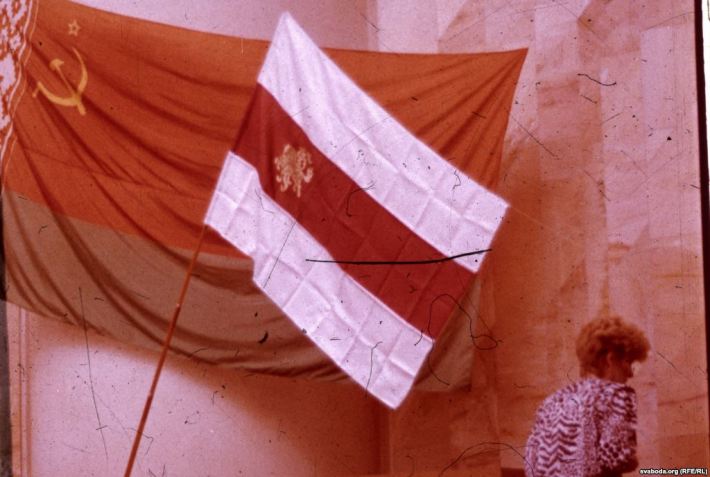
The next day, August 25, the Declaration on State Sovereignty, which was adopted on July 27, 1990 by the Supreme Council, was given the status of constitutional law.
44. September 19, 1991. The Supreme Council of the BSSR adopted laws "On National flag Republic of Belarus ”and“ About State emblem Republic of Belarus ”, as well as the name of our country. In accordance with these laws, the country began to be called the Republic of Belarus and a new state symbol was introduced - the white-red-white flag and the Pogonya coat of arms.
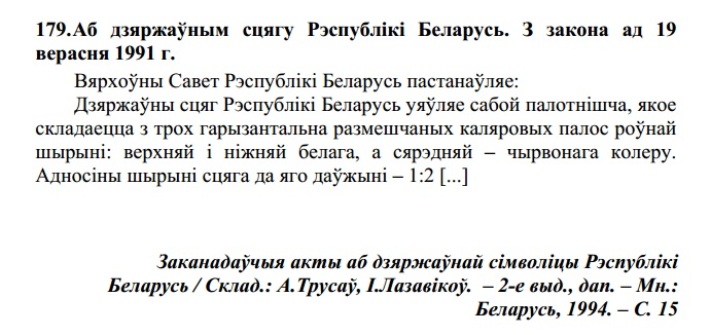
45. September 1991. Immediately after the adoption of the law "On national symbols”A white-red-white flag appeared on the Government House, which the BNF deputies had brought in advance.

46.1993 year. A book of Vintsuk Vyachorka with illustrations by Pyotr Drachev for preschool and primary school age “On the coat of arms and flag” was published. The book sold over a hundred thousand copies. Since then it has not been reprinted.
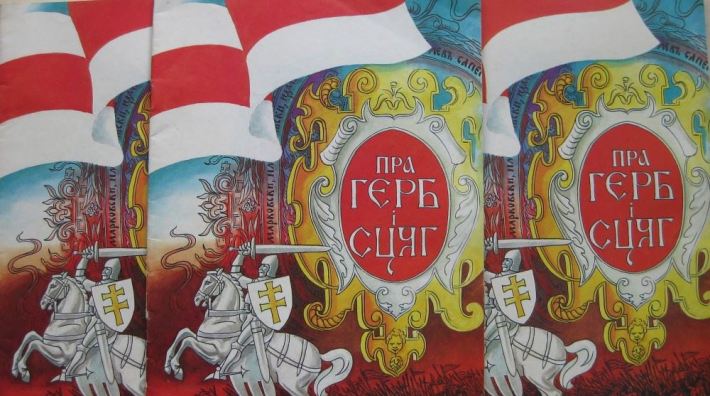
47. July 27, 1994. The Independence Day of the Republic of Belarus is celebrated. Writes by Yuri Malyarevsky:
“Independence Day on July 27, 1994 differed from the previous ones in that a real holiday was felt. Each one had his own, but there was something in common that unified everyone that day. Therefore, in the holiday columns there were such different and painfully familiar people who felt like citizens of one state. Look at the pictures: three grandmothers, the same age of October 1917, the clergy, which, as expected, were next to their parishioners that day (although not quite nearby, but not far away), happy Zenon Poznyak, judicious and thoughtful Vasil Bykov, Rygor Borodulin ... Eh, how would I like that little boy who sat on his father’s neck with a white-red-white flag, for whom not so long ago we had been given the opportunity to taste "rubber with bird cherry", felt like a Belarusian, a worthy man and a real patriot of his homeland. So that after a hundred, two hundred years, and after all eternity, the descendants worthily celebrate the bright holiday - Independence Day, pronouncing the eternal words: Long live Belarus! ”
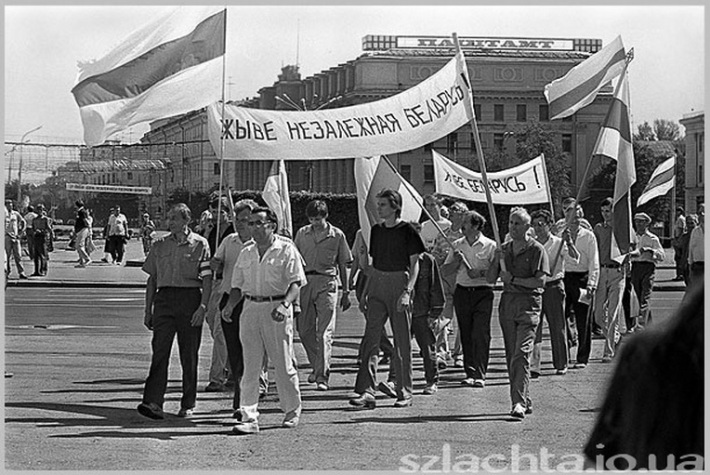
48. July 20, 1994. Under the white-red-white flag, the inauguration of the first president of Belarus, Alexander Lukashenko, took place.

49. May 31, 2013. A music collection entitled “Symbols of Faith and Freedom” has been released, which is dedicated to the white-red-white flag and the coat of arms “Pursuit”.
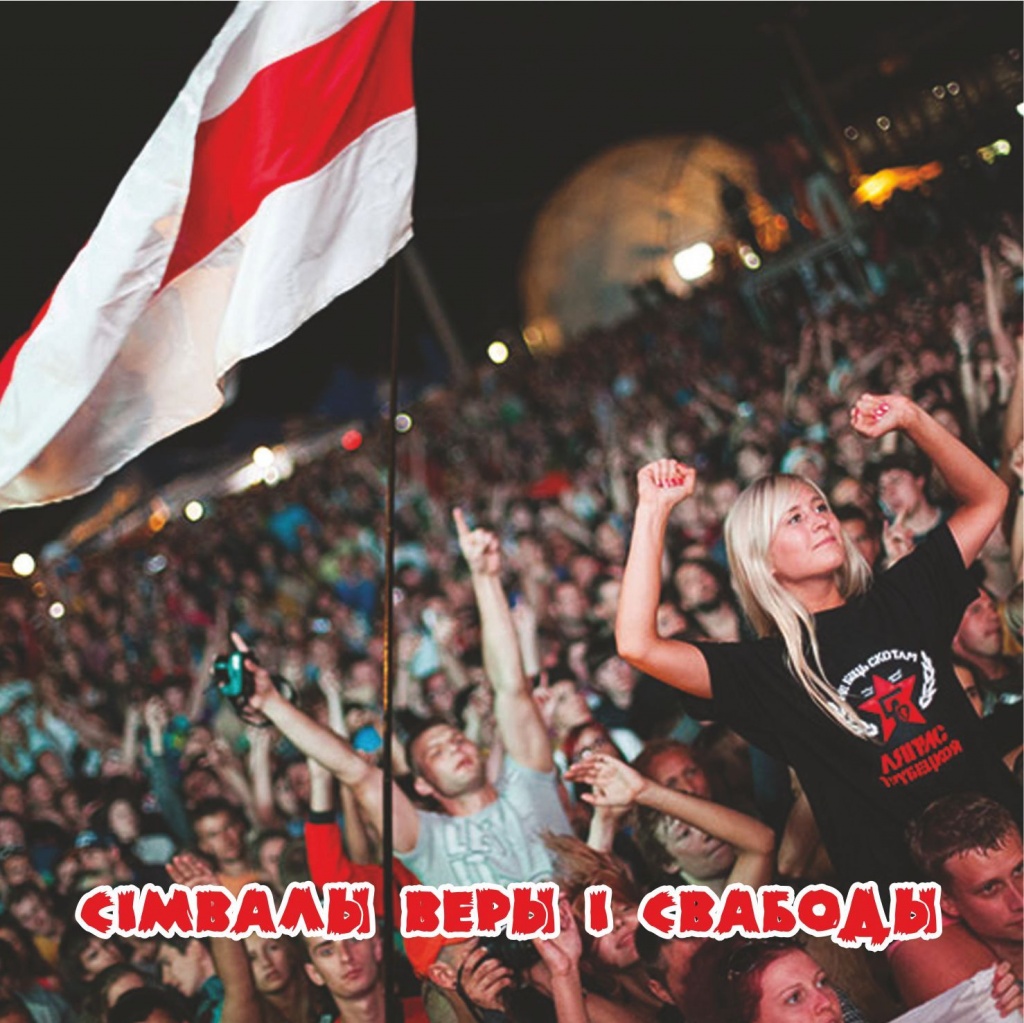
50. October 2013. Oleg Trusov and Alevtina Vyachorka handed over to the editorial office of Art Syadziba the originals of the negative, the first photographs and documents from which the state symbols of the Republic of Belarus were printed and replicated in 1991, as well as the first acts on the adoption of the flag and coat of arms.
- The training system according to the Dalton plan - the organization of the educational process - Sergei V. Sidorov
- Internal differences, specialization of individual cities
- Consonant and letter th
- Not a single word: whom to work after philology
- Warning flags on the beach
- Abstract of speech therapy classes in elementary school
- Sound and Alpha Word Analysis

 Live journal
Live journal Facebook
Facebook Twitter
Twitter